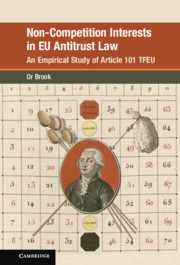Book contents
- Non-Competition Interests in EU Antitrust Law
- Global Competition Law and Economics Policy
- Non-Competition Interests in EU Antitrust Law
- Copyright page
- Contents
- Figures
- Tables
- Acknowledgements
- Definitions
- Abbreviations
- 1 Introduction and Methodology
- 2 History of Article 101 TFEU Balancing
- 3 Article 101(3) TFEU
- 4 Block Exemption Regulations
- 5 Article 101(1) TFEU
- 6 National Balancing Tools
- 7 Enforcement Discretion
- 8 Conclusion
- Book part
- Laws, Regulations, Reports, and Policy Papers
- Case Law
- Bibliography
- Index
2 - History of Article 101 TFEU Balancing
Published online by Cambridge University Press: 06 June 2022
- Non-Competition Interests in EU Antitrust Law
- Global Competition Law and Economics Policy
- Non-Competition Interests in EU Antitrust Law
- Copyright page
- Contents
- Figures
- Tables
- Acknowledgements
- Definitions
- Abbreviations
- 1 Introduction and Methodology
- 2 History of Article 101 TFEU Balancing
- 3 Article 101(3) TFEU
- 4 Block Exemption Regulations
- 5 Article 101(1) TFEU
- 6 National Balancing Tools
- 7 Enforcement Discretion
- 8 Conclusion
- Book part
- Laws, Regulations, Reports, and Policy Papers
- Case Law
- Bibliography
- Index
Summary
This chapter provides a historical overview of the development of Article 101 TFEU balancing to frame and identify the uncertainties surrounding it. The chapter begins with the EU primary and secondary law provisions, illustrating that they do not prescribe a clear balancing framework. Against this backdrop, it shows that the balancing principles have been greatly shaped by the practices of the Commission and EU Courts. It affirms that the development of the balancing principles is best understood by sorting the practices into four enforcement periods, which are then explored throughout the empirical chapters of the book. In addition to the developments at the EU level, the chapter devotes special attention to the competition law set-up and balancing approaches of each of the five Member States examined in the study.
Keywords
- Type
- Chapter
- Information
- Non-Competition Interests in EU Antitrust LawAn Empirical Study of Article 101 TFEU, pp. 34 - 92Publisher: Cambridge University PressPrint publication year: 2022

